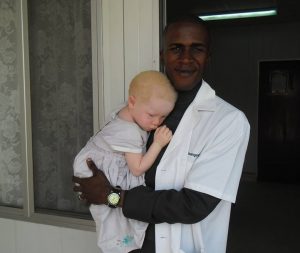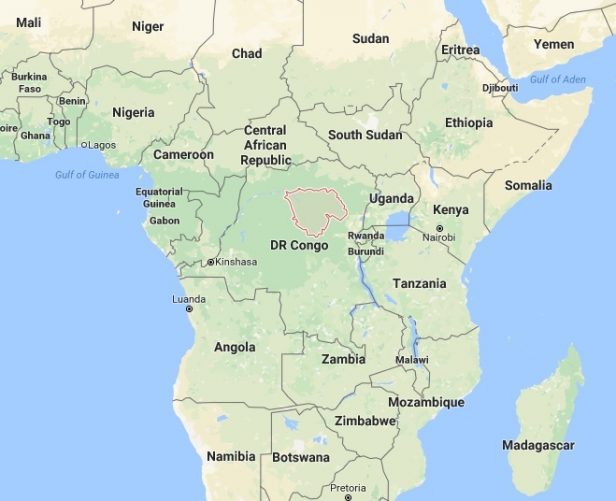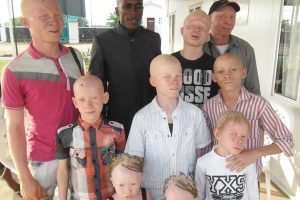Alexa Travels > The Journey > Humanitarian Musings > Albinism in the DRC
Albinism in the DRC
While in the Democratic Republic of the Congo (DRC) I had the pleasure of meeting a physician who has dedicated his life’s work to a specific subset of the world’s population: those affected by the condition called albinism. According to the World Albinism Alliance, albinism is an inherited condition characterized by a lack of the pigment melanin in the skin, hair, and eyes. In nature albinism has been observed in everything from sea turtles to redwood trees (although among plant species it is a lack of chlorophyll, not melanin, that causes the lack of color) and has garnered admiration the world over; from Snowflake, the famous albino Western lowland gorilla at the Barcelona Zoo to an albino male sperm who inhabited the Pacific Ocean I the early 19th century and later inspired Herman Melville’s novel Moby-Dick.
In humans albinism occurs globally, crossing all gender, racial, and ethnic lines. Although the prevalence of albinism varies between regions, the highest rates can be found in Sub-Saharan Africa where it is estimated that 1 in 5,000 to 15,000 persons are affected. Meanwhile, in North American and Europe, the prevalence is roughly 1 in 20,000. Albinism is caused by a recessive gene and both parents must possess the gene for it to be carried on. Parents themselves do not need to have albinism to produce a child with albinism. If both parents possess the gene there is a 25% chance their offspring will have the condition. According to the literature, the term “person with albinism” is preferred over “albino” as it puts the person before their condition.
The Genetic Inheritance of Albinism
Growing up in the US, I can only remember encountering a few people with the condition. Given the heterogeneous nature of the American population and available health resources, I’d venture to guess a person with albinism can more readily blend in and support their specific health needs. But what of folks with the condition living in a society like the DRC where they stand out in stark contrast to the population at large and widespread poverty (63% live below the poverty line) means limited resources to support their wellbeing? I wanted to know more.
Dr. Inena with a Child with Albinism (Photo Courtesy of Dr. Inena)
Dr. Gaylord Inena’s passion for the genetic condition and the people living with it is contagious. He is quick to answer questions as part of his mission to educate people on the condition and advocate for those living with it. In the waiting room of l’Hôpital du Cinquantenaire de Kisangani where Dr. Inena practices, a poster proudly displayed reads “Albinisme Dans la Nature” and shows a dramatic array of wild animals with the condition. I was eager to know more about albinism in the Congolese context. We broached the topic in the cool of evening on a terrace in Kisangani, the capital city of the northern Province of Tshopo.
Map with the Democratic Republic of the Congo, the Tshopo Province Indicated in Red
Having read that people with albinism are prone to vision problems I was curious what conditions linked to albinism Dr. Inena had witnessed in his hospital. I asked him about the biggest struggles individuals with albinism face in maintaining their health. The conversation that followed was shocking.
Dr. Inena set the stage by explaining that people with albinism in the Tshopo province are among the most exposed to the ultra violet rays in the world. Geographically the province falls right on the equator where the sun is its strongest. As albinism is due to the absolute or relative deficiency of melanin, people with albinism have little to no innate protection from ultra violet rays and are prone to dermatological diseases. Most frequently in the Tshopo Province Dr. Inena sees patients suffering from skin cancer—and it’s often lethal. He pulled out his phone and began flipping through photos he had taken of his patients, pre and post operation to remove cancerous lesions from the face, head, neck, and shoulders; areas of the body most difficult to keep protected from the brutal sun. My jaw dropped. Seeing the size and severity of the ulcerous growths was arresting. I couldn’t imagine allowing a treatable condition to progress to these stages, but that’s the trick; skin cancer must be caught early to be treated successfully. Yet according to Under the Same Sun, an organization dedicated to albinism education and advocacy based in Tanzania, many are not aware of the danger from the sun and lack the knowledge or the resources to protect themselves. Shockingly, most children with albinism in Sub-Saharan Africa have early-stage skin cancer by age 10 and only 2% will live beyond age 40.
Persons Attending an Event to Identify Albinism Cases in Kisangani, DRC (Photo Courtesy of Dr. Inena)
Albinism is also accompanied by problems with vision, Dr. Inena continued, nystagmus, amblyopia, myopia, photophobia, decreased visual acuity… He rattled off a long list of vision impairments I had little knowledge of. This is because albinism affects the structure and pigmentation of the eye causing visual impairment and often blindness. Dr. Inena also noted that they have also encountered some patients with Hermansky-Pudlak syndrome, a very rare and lethal disorder marked by impaired blood clotting.
Dr. Inena explained to me that in the Congolese context, these health issues are compounded by the fact that nationally there is no support to manage the health of people living with albinism. Doctors and nurses are not trained how to provide care for people with albinism, dermatological drugs are expensive and rare, and there is no production or steady supply of sunscreen in the country. In his province of Tshopo, Dr. Inena is the only dermatologically trained physician and there isn’t an ophthalmologist in the whole of the province. Furthermore, if a Congolese couple wanted genetic counseling before having children to identify if they are carriers of the gene for albinism, there isn’t a geneticist in the DRC to conduct it.
Next, I asked about the struggles individuals with albinism face socially. Dr. Inena began by explaining that most of the persons with albinism in the DRC and in his province come from poor families with precarious social statuses. The difficulties start at birth—a normally joyous event—which triggers divorce and sometimes abuse as the mother is accused of being responsible for the birth of an albino child. In different social environments, persons with albinism are often ill-received because of their appearance. This is particularly aggravated when they have malodorous and untreated cancerous wounds. They may be rejected by their peers and even members of their family. As a result, few Congolese with albinism finish school and fewer go on to get a job.
Continuing on this thread of social acceptance I asked about the biggest misconceptions about albinism in the DRC. Dr. Inena offered that the most common misconceptions related to the cause of the condition. These vary by area of the country, Dr. Inena clarified, but some Congolese believe that albinism is caused by the mother committing adultery, or as a punishment from God, or because the family is bewitched. Still others believe it is a grandparent or deceased person who is reborn. The cases of divorce after the birth of an albino child often stem from the misconception that it is only the mother who carries the genes and not the father. Some people avoid touching or even seeing an albino person for fear of giving birth to an albino child in the future. Even more frightening, in some parts of Eastern DRC persons with albino are considered mystical people whose body parts possess magical powers. These powers are thought to help fisherman catch many fish, politicians win elections, miners find precious minerals, and witchdoctors conduct ceremonies. So much so that Under The Same Sun reports an increased demand for albino body parts leading up to elections. This misconception has led to the creation of a notorious black market for the body parts of albino persons, who are killed and mutilated for their limbs. This black market is fueled by high prices for albino body parts. Dr. Inena mentioned the rate of $10,000 per limb, while a complete body can sell for as much as $75,000 per a 2009 report by the International Federation of Red Cross and Red Crescent Societies.
As unbelievable as this phenomenon is, it’s not exclusive to the DRC. The neighboring country of Tanzania is home to some of the highest rates of albinism (some figures putting it as high as 1 in 1,400 persons and with it, some of the highest rates of violence against persons with albinism in the world. According to Under the Same Sun, “there is a black market for [albino] body parts, hair and skin used by witch-doctors in potions and charms. The nature of attacks can range from maiming to death to desecrating a grave”. Earlier this month the New York Times published a horrific and visually stunning article about the plight of persons with albinism in Mozambique and Malawi called The Hunted. The short UNICEF film below recounts the story of a young woman in Tanzania who fell victim to an attack in her own home.
This is Kulwa and this is Her Story
Now thoroughly horrified about the dangers for persons with albinism in the region I asked Dr. Inena what needs to be done to improve their lives. First, he started with conviction, the DRC needs to establish legal protections for persons with albinism, because they are currently very vulnerable. Then there is a need to establish a national program for the comprehensive management of the health problems related to albinism in the DRC, like the programs to combat other diseases such as HIV/AIDS, Tuberculosis, Malaria, etc. In addition, the DRC needs to organize a national network of all associations working on albinism in the country, as the current associations have evolved in isolation without coordination. Furthermore, there is no reliable data on albinism in the DRC. Research is needed.
My final question for Dr. Inena was one of hope. What was his vision for the future of persons with albinism in the DRC? In addition to implementing what he had already mentioned, Dr. Inena dreams of creating a better system of care for persons with albinism throughout the country. He would like to provide scholarships for the training of specialists in dermatology, ophthalmology, and genetics to provide quality care to people living with albinism. He would like to assure that every albino person is entitled to at least two dermatological consultations per years to detect and treat pre-cancerous lesions and skin cancers, plus ophthalmological consultations. He would like to train teachers of children with albinism on special teaching methods adapted for children with vision problems to help integrate children with albinism into the schools. Dr. Inena already spends his own money to pay for radio and television advertisements to create awareness about the condition in Kisangani, but he would like to scale this up to the national level. He also has the idea to build a factory to locally produce sunscreen and liquid nitrogen (needed to remove cancerous growths)—if he can obtain funding. Dr. Inena spoke with excitement about how a group in Tanzania was locally producing sunscreen specially designed for people with albinism. Finally, he would work to facilitate access to sunscreens and pharmaceutical products necessary for the health and wellbeing of persons with albinism.
Many persons with albinism in the DRC and other African nations live a harrowing reality. They are at a dire crossroads; exposed to some of the harshest of sunlight on the planet, poverty limits access to prevention and treatment for maladies linked to albinism, and superstition fueled by perversely high monetary incentives keep their very lives at risk. There is clearly much to be done to elevate persons with albinism to full members of society, and I imagine it will take many passionate souls to make the vision of Dr. Inena a reality. There is much to be done.
Interview translated from French




Very interesting and deep subject about persons with albinism.congratulations Dr Inena,you are one among million dedicated in this noble task.May God bless you
many thanks Dr fabruce Ngoma
many albinos at gbadolite are not partner to help them, no one medical to them, and ONGD-ACSD for sicklanemy at gbadolite identifing twenty albinist to put them betwen the vulnerable to help, we continue to make the identication, we have our new medical center, so we are looking partner to give us financy to procured purls, medicament, the materiels of laboratory